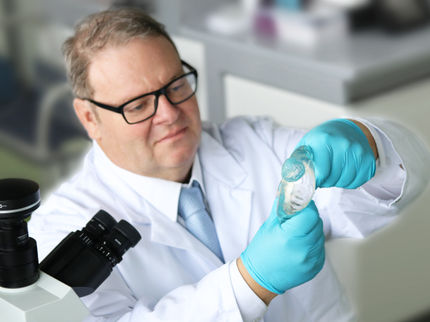Ointment with DNA molecules combats allergic contact dermatitis
Study shows that what are known as aptamers can be absorbed directly via the skin
Advertisement
Researchers at the University of Bonn have isolated a DNA molecule that is suitable for combating allergic contact dermatitis in mice. What is known as an aptamer binds to certain immune system messenger substances, rendering them ineffective. This even works if the active ingredient is applied to the skin in the form of an ointment. The working groups involved hope that aptamer creams such as this could also be suitable for treating other skin conditions. The results have now been published in the journal Molecular Therapies - Nucleic Acids.

Fluorescence microscopic imaging of the skin treated with the aptamer cream: - The aptamers (here marked in pink) were applied to the top layer of the skin in the form of an ointment and also penetrate into the deeper dermal layers (nucleus: blue; antigen-presenting cells: green).
Marlene Gottschalk
DNA is a long molecule in which different elements are joined up in a row, similar to the letters in a sentence. Just as a sentence stores information, so can DNA threads. At the same time, DNA is sticky, almost like a kind of mini Velcro fastening. It exists in the chromosomes in the form of two parallel strands whose “adhesive surfaces” face each other.
Aptamers, however, are single-stranded. This allows them to bind to other molecules and influence their function. Which molecules they bind to depends on the sequence of their elements: Different aptamers bind to different molecules in a very specific way. And it is precisely this point that makes them interesting to active ingredient research.
Fishing in the aptamer library
“Today, it is relatively easy to produce huge libraries of aptamers, the sequence of which differs at random,” explains Prof. Dr. Günter Mayer from the LIMES Institute (the acronym stands for “Life and Medical Sciences”) at the University of Bonn. “Some of these libraries contain millions more potential active ingredients than there are people alive on Earth.”
If you want to inhibit a certain target structure with aptamers, you only need to use them as fishing hooks: If you dip them into the mix, the right aptamer threads stick to them. “We used this method to isolate aptamers that adhere to a certain immune protein called CCL22,” says Mayer, who is also a member of the Transdisciplinary Research Areas “Matter” and “Life & Health” at the University of Bonn. “We then chemically modified and further optimized these hits.”
Immune system attractant
CCL22 is what is known as a chemokine, which is a substance that controls the migration of cells in the body. If certain immune cells detect elements of a bacterium or a virus, they release chemokines and thus call the body’s defense forces for assistance.
A similar thing also happens with allergic contact dermatitis: The body’s proteins are modified by the allergen – such as a necklace containing nickel. These actually harmless changes are perceived as foreign by the immune system, which, among other things, leads to the release of CCL22. The CCL22 then attracts T cells, which migrate to the site of the action. The result is an allergic reaction.
Aptamer ointment helps mice
“We have now administered an aptamer against CCL22 to mice,” explains Mayer’s colleague Prof. Dr. Irmgard Förster. The scientist conducts research into “Immunology and Environment” at the LIMES Institute at the University of Bonn and is also a member of the Cluster of Excellence “ImmunoSensation2” and the Transdisciplinary Research Area “Life and Health”. “This blocked the chemokine to a certain extent. Metaphorically speaking, the nose of the T cells was no longer able to detect the attractant bonded to the aptamer.”
As a result, the allergic skin reaction decreased following the treatment with the aptamer. Incredibly, this even works if the active ingredient has been applied to the inflamed areas in the form of an ointment. “This has enabled us to show for the first time that aptamers can also be administered in this form,” highlights Günter Mayer. “The two lead authors Anna Jonczyk and Marlene Gottschalk, who conducted the experiments, were themselves surprised by this result and were thrilled by the future therapeutic potential.”
Still unclear whether the approach also applies to humans
The researchers now want to investigate whether this also works for other skin conditions. “It may also be possible to treat conditions such as atopic dermatitis or even malignant melanoma with special aptamer creams against this or other target proteins,” hopes Irmgard Förster. “However, our results so far only apply to mice. It remains to be seen whether the approach also applies to humans.”
Participating institutions and funding
The Institute of Innate Immunity at University Hospital Bonn and the University of Melbourne (Australia) are involved alongside the LIMES Institute and the Centre of Aptamer Research and Development at the University of Bonn. The study was supported with funds from the German Research Foundation (DFG).



























































